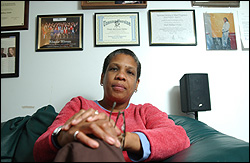A crucial question has surrounded a committee of 14 business and civic leaders seeking solutions to the Seattle School District budget crisis: How will school choice figure in? The popular though expensive program allows students to apply to any of a wide range of schools around the city, and restricting that choice to save money on transportation had been key last spring in Superintendent Raj Manhas’ initial plan to deal with the steadily increasing expense of running the 46,000-student system. In fact, curtailing school choice was a big reason Manhas’ plan was dead on arrival. When he withdrew it, he formed the Committee for Investing in Educational Excellence and said he would put great stock in whatever solutions it offered. Their challenge: Expenses are growing by 4 percent annually while revenues are growing by only 2 percent.
The answer regarding choice came at a public meeting Nov. 1, where the committee revealed preliminary recommendations and asked for feedback. School choice was not among them, and in an interview at the meeting, John Warner, the committee’s co-chair and a retired Boeing executive, told Seattle Weekly that the choice issue is beyond the group’s purview and “not on the agenda.” Added Warner: “That’s a policy decision. The district has to deal with that.”
It’s clear, though, that in declining to consider restricting school choice, the committee made a judgment call, taking into consideration the uneven quality of schools that is defined to a great degree by affluence in northern neighborhoods and modest means in the south. “If we get to the point where all schools are equally good, then the issue of choice becomes more of an issue, perhaps,” Warner said. “But that’s down the road.” Added Trish Dziko, the committee’s other co-chair and executive director of the Technology Access Foundation: “Look at it this way. If we got rid of choice, the [student-performance] equity issue would be even worse than it is now, and it is horrible.”
The committee actually has considered many policy issues. Given a mission to develop a financial plan that will advance achievement, members decided to delve into the academic side of the equation with gusto. At the meeting, they unveiled eight of a projected 26 recommendations. Each came on a concise, one-page sheet that spelled out a rationale and the financial ramifications. And as it turned out, the committee’s determination to improve academics resulted in five of those eight suggestions actually costing more money. They included shrinking teacher-student ratios in core elementary school classes and poorly performing schools, funding six periods a day in high school instead of five, and making science basic to the curriculum.
Meanwhile, if no cuts are made, the annually compounding expense-revenue gap will add up to a $41 million deficit by 2008, according to the committee’s analysis. “The way we’re trying to approach this is not just talking about slashing money but, first of all, what does it take to build a fantastic school system?” says Sara Morris, the committee’s staffer. She acknowledges that the time-consuming attempt to “get clarity on the academic vision” is responsible for a delay of final recommendations. Originally scheduled to be presented by Dec. 15, the committee now says they’ll be ready in February.
Three cost-saving recommendations were on display at the meeting. One concerned transportation—but not choice. Among other ideas to reduce costs was a fee-based transportation system with a sliding scale for low-income students. After a period of time devoted to getting feedback from audience members, who milled about tables set up to explain each idea and filled out comment cards, Warner said he was surprised how many people supported the transportation fee concept.
The committee is looking, too, at closing schools. A proposal to close 10 schools was another reason Manhas’ plan was so unpopular, but committee members say there’s no getting around the fact that there are nearly as many buildings as in the 1960s, while there are half as many students. The committee is recommending that the district’s property “footprint” be reduced. While the superintendent’s earlier plan axed some of the district’s highest achieving schools, this time, Dziko says, “there’s going to be a lot more logic to it.”
The committee’s other cost-saving idea was to generate more revenue from the surplus property, a no-brainier that has wide appeal, although, as one audience member pointed out, the Port of Seattle has gotten a lot of criticism by venturing into real-estate development without the expertise to do so wisely.
Whether these and other recommendations the committee comes up with will add up to adequate savings remains to be seen. But so far, the committee’s positive, academic-focused approach has created an upbeat mood among those who have been following it. “What you guys are doing is awesome!” one audience member gushed to Dziko. That’s the kind of approval that is rarely heard in contentious and often dispiriting school politics.








